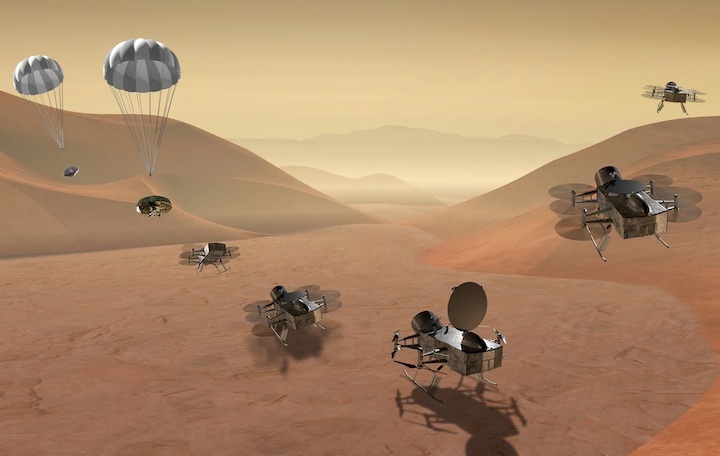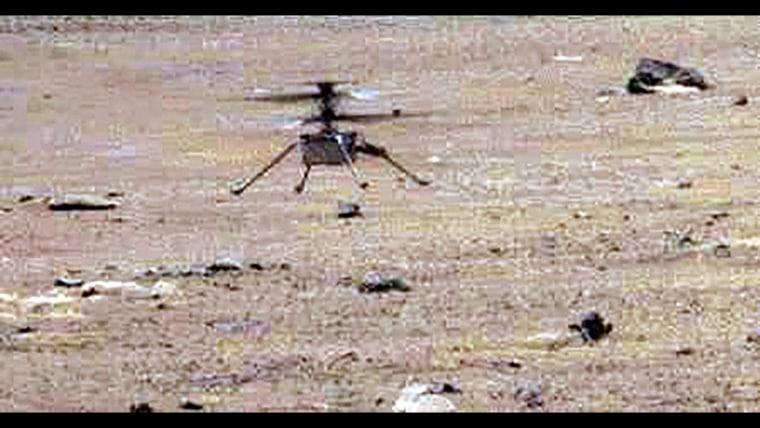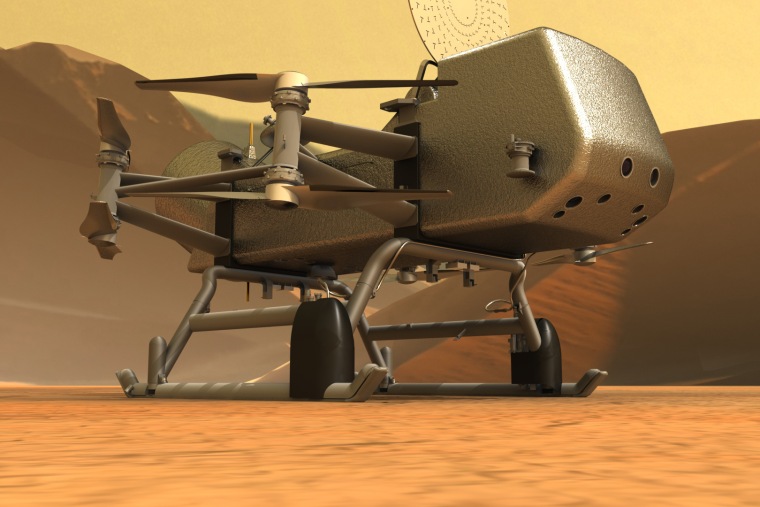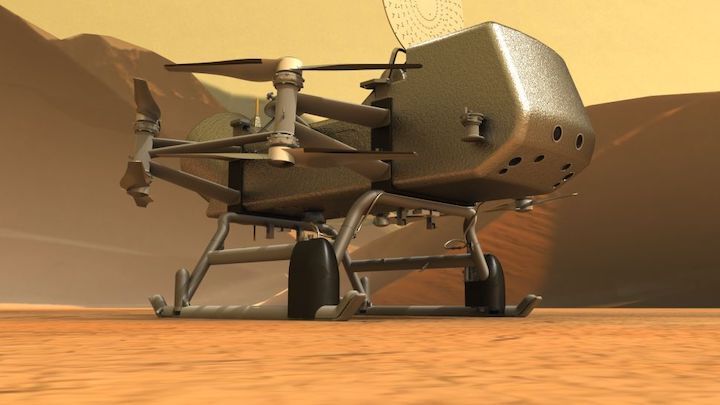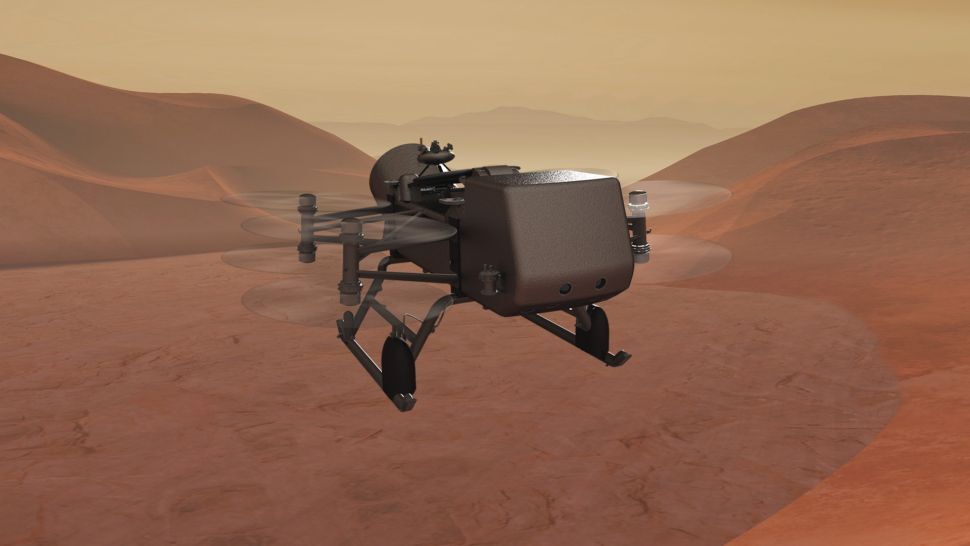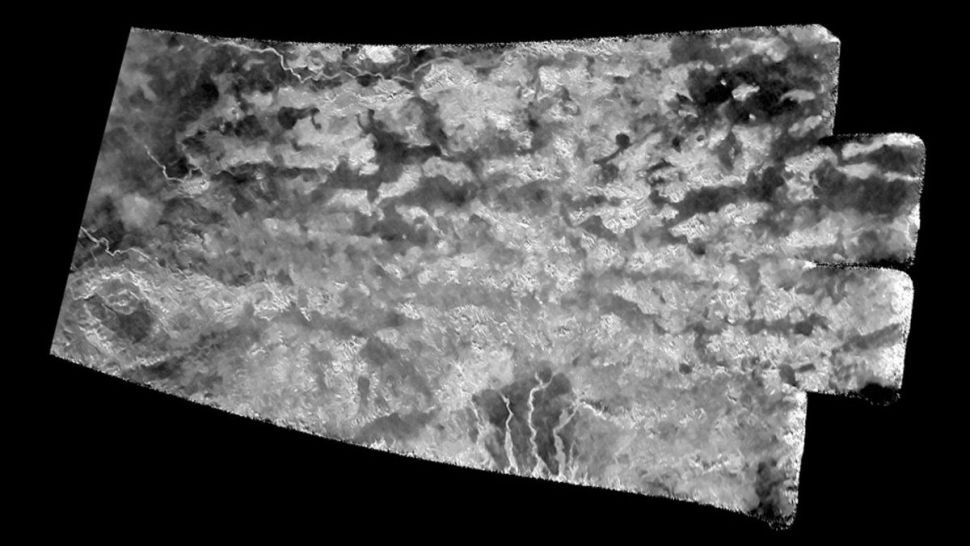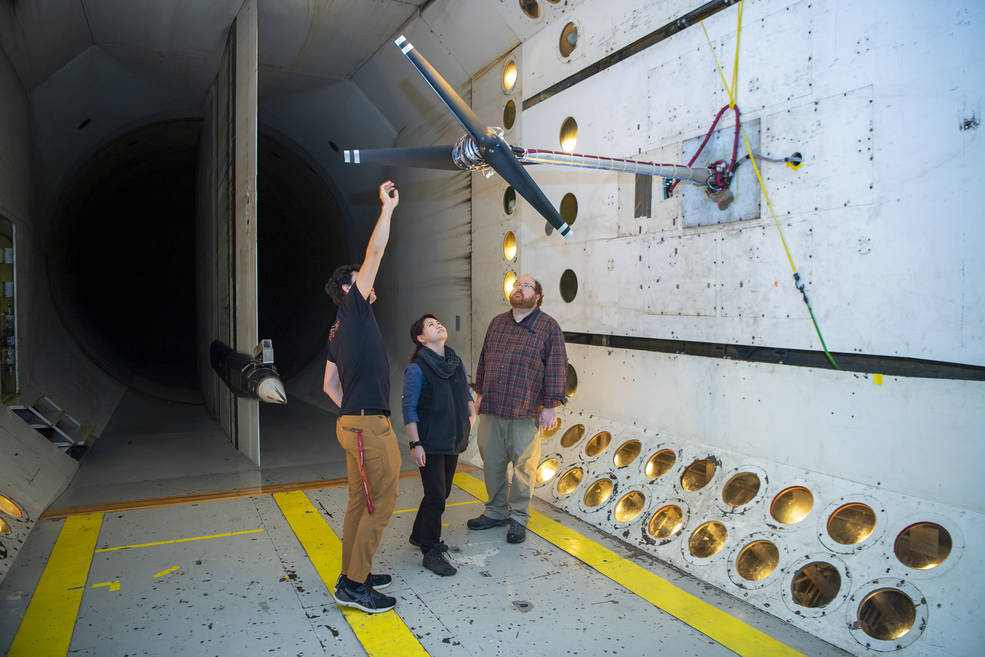28.06.2019
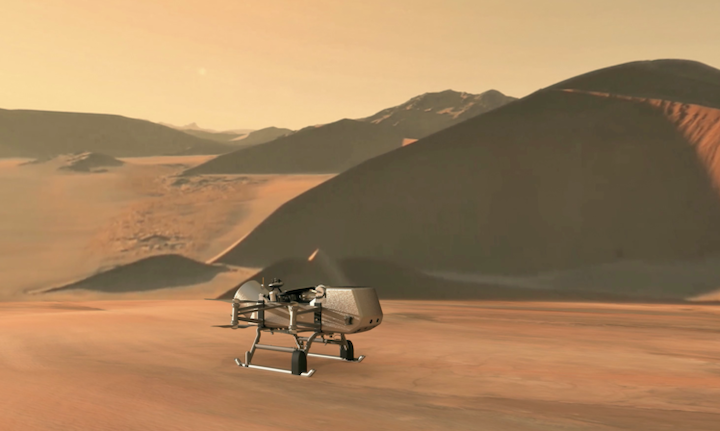
NASA has announced that our next destination in the solar system is the unique, richly organic world Titan. Advancing our search for the building blocks of life, the Dragonfly mission will fly multiple sorties to sample and examine sites around Saturn’s icy moon.
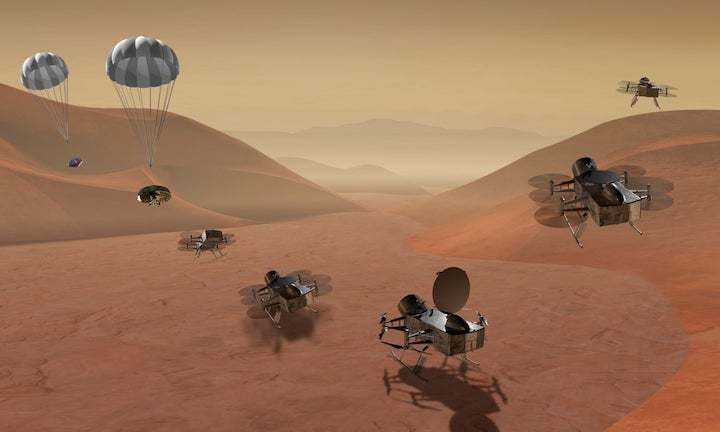
Dragonfly will launch in 2026 and arrive in 2034. The rotorcraft will fly to dozens of promising locations on Titan looking for prebiotic chemical processes common on both Titan and Earth. Dragonfly marks the first time NASA will fly a multi-rotor vehicle for science on another planet; it has eight rotors and flies like a large drone. It will take advantage of Titan’s dense atmosphere – four times denser than Earth’s – to become the first vehicle ever to fly its entire science payload to new places for repeatable and targeted access to surface materials.
Titan is an analog to the very early Earth, and can provide clues to how life may have arisen on our planet. During its 2.7-year baseline mission, Dragonfly will explore diverse environments from organic dunes to the floor of an impact crater where liquid water and complex organic materials key to life once existed together for possibly tens of thousands of years. Its instruments will study how far prebiotic chemistry may have progressed. They also will investigate the moon’s atmospheric and surface properties and its subsurface ocean and liquid reservoirs. Additionally, instruments will search for chemical evidence of past or extant life.
“With the Dragonfly mission, NASA will once again do what no one else can do,” said NASA Administrator Jim Bridenstine. “Visiting this mysterious ocean world could revolutionize what we know about life in the universe. This cutting-edge mission would have been unthinkable even just a few years ago, but we’re now ready for Dragonfly’s amazing flight.”
Dragonfly took advantage of 13 years’ worth of Cassini data to choose a calm weather period to land, along with a safe initial landing site and scientifically interesting targets. It will first land at the equatorial “Shangri-La” dune fields, which are terrestrially similar to the linear dunes in Namibia in southern Africa and offer a diverse sampling location. Dragonfly will explore this region in short flights, building up to a series of longer “leapfrog” flights of up to 5 miles (8 kilometers), stopping along the way to take samples from compelling areas with diverse geography. It will finally reach the Selk impact crater, where there is evidence of past liquid water, organics – the complex molecules that contain carbon, combined with hydrogen, oxygen, and nitrogen – and energy, which together make up the recipe for life. The lander will eventually fly more than 108 miles (175 kilometers) – nearly double the distance traveled to date by all the Mars rovers combined.
“Titan is unlike any other place in the solar system, and Dragonfly is like no other mission,” said Thomas Zurbuchen, NASA’s associate administrator for Science at the agency’s Headquarters in Washington. “It’s remarkable to think of this rotorcraft flying miles and miles across the organic sand dunes of Saturn’s largest moon, exploring the processes that shape this extraordinary environment. Dragonfly will visit a world filled with a wide variety of organic compounds, which are the building blocks of life and could teach us about the origin of life itself.”
Titan has a nitrogen-based atmosphere like Earth. Unlike Earth, Titan has clouds and rain of methane. Other organics are formed in the atmosphere and fall like light snow. The moon’s weather and surface processes have combined complex organics, energy, and water similar to those that may have sparked life on our planet.
Titan is larger than the planet Mercury and is the second largest moon in our solar system. As it orbits Saturn, it is about 886 million miles (1.4 billion kilometers) away from the Sun, about 10 times farther than Earth. Because it is so far from the Sun, its surface temperature is around -290 degrees Fahrenheit (-179 degrees Celsius). Its surface pressure is also 50 percent higher than Earth’s.
Dragonfly was selected as part of the agency’s New Frontiers program, which includes the New Horizons mission to Pluto and the Kuiper Belt, Juno to Jupiter, and OSIRIS-REx to the asteroid Bennu. Dragonfly is led by Principal Investigator Elizabeth Turtle, who is based at Johns Hopkins University’s Applied Physics Laboratory in Laurel, Maryland. New Frontiers supports missions that have been identified as top solar system exploration priorities by the planetary community. The program is managed by the Planetary Missions Program Office at NASA’s Marshall Space Flight Center in Huntsville, Alabama, for the agency’s Planetary Science Division in Washington.
“The New Frontiers program has transformed our understanding of the solar system, uncovering the inner structure and composition of Jupiter’s turbulent atmosphere, discovering the icy secrets of Pluto’s landscape, revealing mysterious objects in the Kuiper belt, and exploring a near-Earth asteroid for the building blocks of life,” said Lori Glaze, director of NASA’s Planetary Science Division. “Now we can add Titan to the list of enigmatic worlds NASA will explore.”
Quelle: NASA
----
Update: 29.06.2019
.
Destination: Titan
NASA SELECTS JOHNS HOPKINS APL TO LEAD MISSION TO SATURN'S EXOTIC MOON

Artist rendering of Dragonfly on Titan’s surface.
Credit: Johns Hopkins APL
Destination: Titan – Dragonfly is a rotorcraft lander mission in NASA's New Frontiers program designed to take advantage of Titan's environment to sample materials and determine surface composition in different geologic settings.
Credit: Johns Hopkins APL
It sounds like science fiction: fly a robotic rotorcraft over the dunes of an alien moon. But NASA is giving a team led by the Johns Hopkins Applied Physics Laboratory (APL) in Laurel, Maryland, the opportunity to turn this idea into space exploration reality.
NASA announced today that it has selected Dragonfly, a rotorcraft-lander expedition to Saturn’s large, exotic moon Titan, as the next mission in its New Frontiers program. Launching in 2026 and arriving in 2034, Dragonfly will explore dozens of locations across Titan, sampling and measuring the composition of Titan’s organic surface materials to characterize the habitability of Titan’s environment and investigate the progression of prebiotic chemistry.
“Dragonfly is a bold, game-changing way to explore the solar system,” said APL Director Ralph Semmel. “This mission is a visionary combination of creativity and technical risk-taking that will help us unravel some of the most critical mysteries of the universe — including, possibly, the keys to our origins. We’re honored that NASA has entrusted APL and our partners with this great opportunity and responsibility.”
Scientists consider the icy moon Titan to be the most Earth-like world in the solar system, a virtual chemistry lab that can provide clues to how life may have arisen on our planet. During its 2.7-year baseline mission, Dragonfly will explore environments from organic dunes to the floor of an impact crater, where liquid water and complex organic materials key to life once existed together. Its scientific instruments — to be built by institutions across the nation — will study how far prebiotic chemistry may have progressed. They also will investigate the moon’s atmospheric and surface properties and its subsurface ocean and liquid reservoirs.
“Titan is such an amazing, complex destination,” said Elizabeth “Zibi” Turtle, Dragonfly principal investigator from APL. “We don't know the steps that were taken on Earth to get from chemistry to biology, but we do know that a lot of that prebiotic chemistry is actually happening on Titan today. We are beyond excited for the chance to explore and see what awaits us on this exotic world.”
Titan is larger than the planet Mercury and is the second largest moon in our solar system. As it orbits Saturn, it is about 886 million miles (1.4 billion kilometers) away from the Sun, about 10 times farther than Earth. Because it is so far from the Sun, its surface temperature is around minus-290 degrees Fahrenheit (minus-179 Celsius). Its surface pressure is also 50% higher than Earth’s.
Dragonfly took advantage of 13 years’ worth of data from NASA’s Cassini mission to choose its targets. It will first land in the equatorial “Shangri-La” dune fields, which are eerily similar to the linear dunes in Namibia in southern Africa, before moving on to other areas in a series of “leapfrog” flights of around 5 miles (8 km), stopping along the way to take samples from compelling areas with diverse geography. It will finally reach the Selk impact crater, where there is evidence of past liquid water, organics — the complex molecules that contain carbon, combined with hydrogen, oxygen and nitrogen — and energy, which together make up the recipe for life.
Dragonfly also leverages decades of autonomous drone experience and well-understood flight dynamics on Earth — and applies them in a whole new environment. The dense, calm atmosphere and low gravity make flying an ideal way to travel across Titan; the lander — about 10 feet long and 10 feet across from rotor tip to rotor tip — will eventually fly more than 108 miles (175 kilometers), nearly double the distance traveled to date by all the Mars rovers combined.
“With the Dragonfly mission, NASA will once again do what no one else can do,” said NASA Administrator Jim Bridenstine. “Visiting this mysterious ocean world could revolutionize what we know about how life formed in the universe. This cutting-edge mission would have been unthinkable even just a few years ago, but we’re now ready for Dragonfly’s amazing flight.”
APL brings decades of space exploration experience to the Dragonfly challenge. Having built 70 spacecraft and approximately 300 specialized space instruments, APL has led history-making missions to the extremes of the solar system — from Parker Solar Probe’s daring passes through the atmosphere of the Sun, to New Horizons’ exploration of Pluto and the distant Kuiper Belt.
Led by Principal Investigator Zibi Turtle and managed by APL, the Dragonfly mission includes key partners at NASA Goddard Space Flight Center, Lockheed Martin Space, NASA Ames Research Center, NASA Langley Research Center, Penn State University, Malin Space Science Systems, Honeybee Robotics, Jet Propulsion Laboratory, and the Japan Aerospace Exploration Agency. New Frontiers is managed by the Planetary Missions Program Office at NASA’s Marshall Space Flight Center in Huntsville, Alabama, for the agency’s Planetary Science Division in Washington.
Quelle: Hopkins University
+++
What Is Dragonfly?

Dragonfly is a rotorcraft lander mission – part of NASA's New Frontiers Program – designed to take advantage of Titan's environment to sample materials and determine surface composition in different geologic settings. This revolutionary mission concept includes the capability to explore diverse locations to characterize the habitability of Titan's environment, to investigate how far prebiotic chemistry has progressed, and even to search for chemical signatures that could indicate water-based and/or hydrocarbon-based life.
IMAGE CREDIT: Johns Hopkins APL
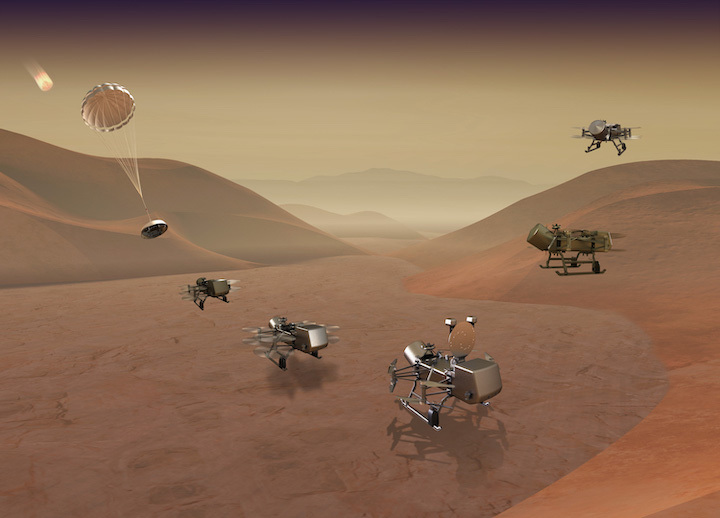
Flying to Sites of Interest Across Titan
Making multiple flights, the Dragonfly dual-quadcopter will explore a variety of locations on Titan. The dense, calm atmosphere and low gravity make flying an ideal way to travel to different areas of the moon – studies from the late-1990s onward identified aerial mobility, such as that provided by helicopters, balloons, and airplanes, as a key enabler for Titan exploration. In under an hour, Dragonfly will cover tens of miles or kilometers, farther than any planetary rover has traveled. With one hop per full Titan day (16 Earth days), the rotorcraft will travel from its initial landing site to cover areas several hundred kilometers away during the planned two-year mission. Despite its unique ability to fly, Dragonfly would spend most of its time on Titan's surface making science measurements.
Unable to use solar power under Titan's hazy atmosphere, Dragonfly will use a Multi-Mission Radioisotope Thermoelectric Generator (MMRTG), like the durable Curiosity rover on Mars. Flight, data transmission, and most science operations will be planned during Titan's daytime hours (eight Earth days), giving the rotorcraft plenty of time during the Titan night to recharge.
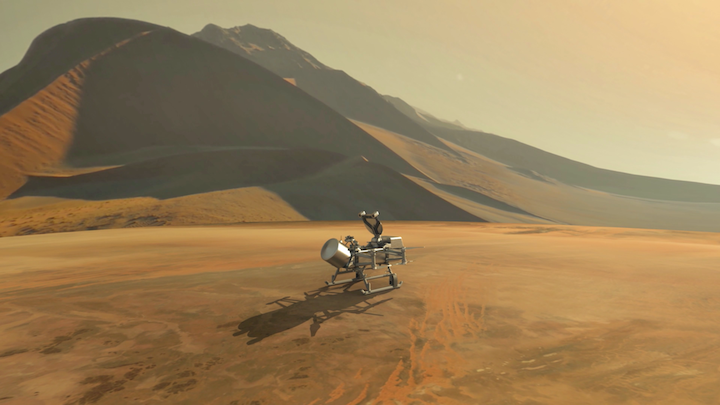
Dragonfly's Surface and Atmospheric Science Measurements...
- Sample surface material and measure with a mass spectrometer to identify the chemical components and processes producing biologically relevant compounds
- Measure bulk elemental surface composition with a neutron-activated gamma-ray spectrometer
- Monitor atmospheric and surface conditions, including diurnal and spatial variations, with meteorology sensors
- Use imaging to characterize geologic features
- Perform seismic studies to detect subsurface activity and structure
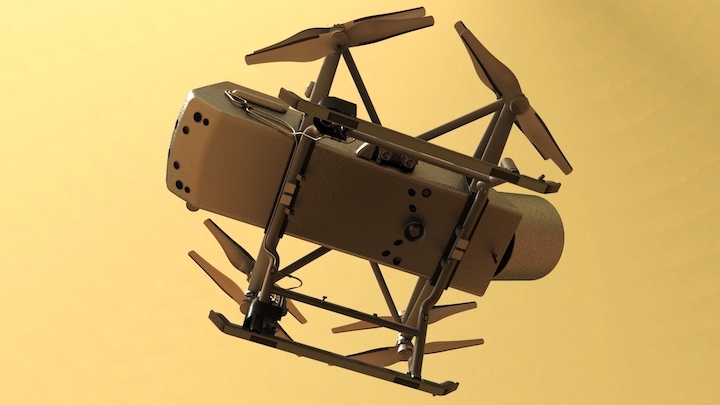
...and In-flight Measurements
- Contribute to atmospheric profiles
- Provide aerial images of surface geology
- Give context for surface measurements and scouting of sites of interest
Why Titan?
The largest moon of Saturn is a high priority for planetary exploration. Titan is an ocean world and the only moon in our solar system with a dense atmosphere, which supports an Earth-like hydrological cycle of methane clouds, rain, and liquid flowing across the surface to fill lakes and seas. The abundant complex organic material accessible on Titan's surface makes it an ideal destination for studying the conditions necessary for the habitability of an extraterrestrial environment and the kinds of chemical interactions that occurred before life developed on Earth.
Our Knowledge of Titan
The two Voyager spacecraft observed Titan in 1979 and 1980, but the organic haze in the atmosphere obscured the surface at visible wavelengths. The Hubble Space Telescope imaged Titan at longer near-infrared wavelengths in 1994, revealing large bright and dark regions on its surface. However, the details of Titan's surface landforms remained a mystery until July 2004, when NASA's Cassini spacecraft arrived. Cassini used radar and imaging at near-infrared wavelengths to glimpse what lies below the hazy atmosphere. During more than 100 close flybys, the Cassini orbiter mapped much of Titan's surface and made detailed studies of its atmosphere. Cassini also delivered the Huygens probe, which in 2005 parachuted safely down to Titan's surface, measured winds and the atmosphere, and imaged a small region of the surface in close-up detail. Cassini's observations also pointed to a salty ocean beneath the moon's water-ice crust, thus earning Titan the label of an "ocean world."
Cassini showed us that Titan's surface has rivers, lakes, and even seas of liquid ethane and methane (the main component of natural gas), as well as vast expanses of sand dunes. The climate of Titan is such that the methane can form clouds and even rain, as water does on Earth. Titan's atmosphere is four times denser than Earth's and its gravity is about 1/7th of Earth's; this combination means Titan's raindrops fall much slower than Earth's. Rainfall on Titan is rare – it may be centuries between showers at a given location.
Titan's atmosphere is composed primarily of nitrogen (about 95%), with some methane (about 5%) and small amounts of other carbon-rich compounds. When exposed to sunlight, the methane and nitrogen molecules are split apart by ultraviolet light and recombine to form a variety of complex organic compounds. Organic molecules are the building blocks for life, and their presence on Titan adds to its intrigue – what compounds are on Titan, and what might they form?
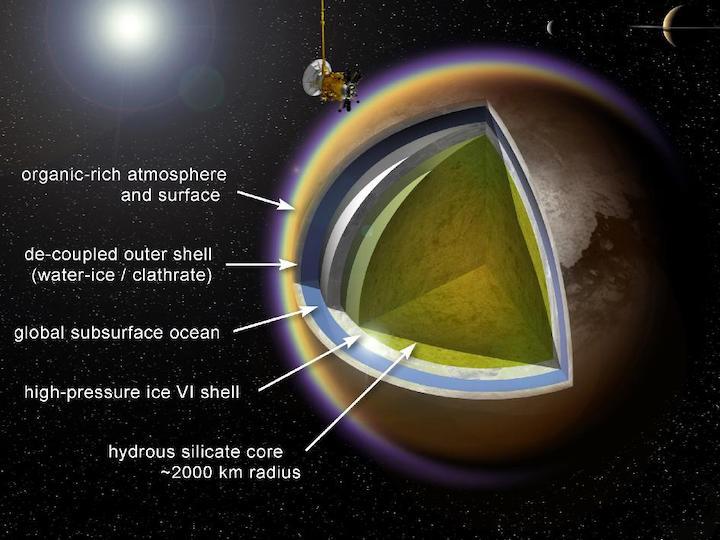
Ocean Worlds
As an ocean world, Titan offers a rare opportunity to explore the origins of prebiotic chemistry outside of Earth's environment. NASA's Ocean Worlds mission theme focuses on characterizing potential habitability, examining prebiotic chemistry, and searching for signs of life. Titan's unique combination of abundant, complex, carbon-rich chemistry on its largely water-ice surface makes it an ideal location for such investigations.
Quelle: Hopkins University
----
Update: 1.07.2019
.
Cassini answers Titan secrets, NASA plans helicopter mission to cloudy world
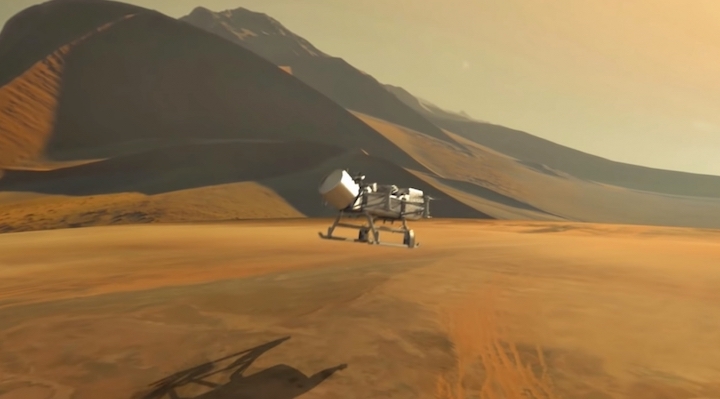
Even though Cassini ended its mission nearly two years ago, data from all of the spacecraft’s flybys of the Saturnian moon Titan continue to help scientists unlock the mysteries of this world shrouded by a thick, dense atmosphere.
Now, NASA is planning a return to this extreme object of interest in the solar system – a location that is quite favorable for harboring life in its methane-rich environment.
Titan offers up secrets to its methane lakes
During its final flyby of Titan in 2017, the Cassini spacecraft trained its radar instruments onto the moon – peering beneath the obscuring cloud layer that envelops Titan to gather data on a series of small liquid methane lakes in the moon’s northern hemisphere.
The data, analyzed by scientists and published earlier this year in Nature Astronomy, offer new glimpses into the depths of the lakes and surrounding terrain at which they reside.
Specifically, Cassini data shows that these methane lakes are surprisingly deep and are perched atop hills.
“Every time we make discoveries on Titan, Titan becomes more and more mysterious,” said lead author of the new study Marco Mastrogiuseppe, Cassini radar scientist at Caltech in Pasadena, California. “But these new measurements help give an answer to a few key questions. We can actually now better understand the hydrology of Titan.”
The data from Cassini revealed that some of the northern hemisphere methane lakes are more than 100 m (300 feet) deep.
Aside from Earth, Titan is the only other known body in the solar system that has stable liquid on its surface; whereas water is that stable liquid on Earth, methane and ethane are those liquids on Titan.
The intriguing thing about these liquid methane lakes and hydrologic cycle is that research from the University of California has shown that life – as it did on Earth with water – can evolve with methane as its liquid medium instead of water, providing tantalizing possibilities into what might be happening in the methane lakes on Titan.
For the lakes investigated in 2017, it is their elevation and depth that adds a whole new set of information to the Titan puzzle – specifically that the hydrologic cycles in the moon’s eastern and western portions of its northern hemisphere are completely different.
“It is as if you looked down on the Earth’s North Pole and could see that North America had completely different geologic setting for bodies of liquid than Asia does,” said Cassini scientist and co-author of the study Jonathan Lunine of Cornell University in Ithaca, New York.
On the eastern side of Titan’s northern hemisphere, methane concentrations are grouped into large seas at low levels of elevation, canyons, and islands.
But on the western side of the northern hemisphere, methane is grouped into small lakes (tens of kilometers/miles across) located atop large hills and plateaus.
And it is specifically the lakes’ depth and high-elevation that provide scientists with evidence that they formed when the surrounding bedrock of ice and solid organics chemically dissolved and collapsed – just like karstic lakes in Germany, Croatia, and the United States that form when water dissolves limestone bedrock.
The new data has allowed scientists to better understand how Titan’s hydrologic cycle is quite similar to that of Earth’s, just with methane instead of water.
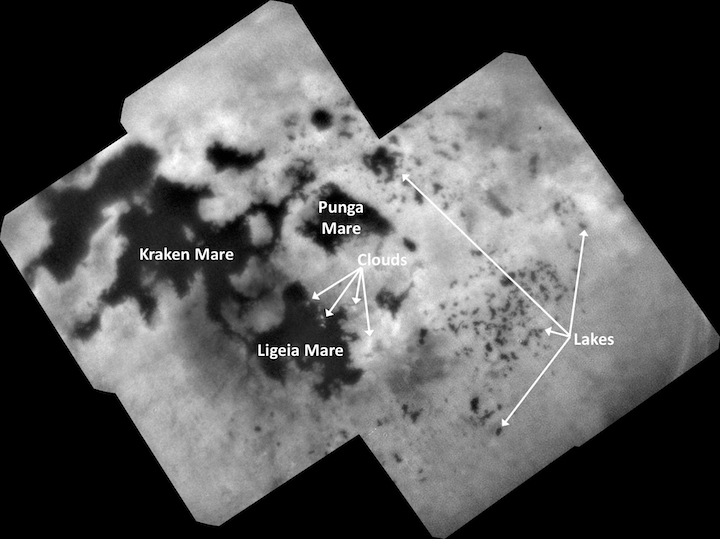
The information also provides a stronger link to Titan’s similarities to Earth and continues to enshrine the moon’s position as a key location for research in the solar system and one of the prime locations where life might have developed and still exist off Earth.
The data gathered by Cassini for this study was acquired by the spacecraft on 22 April 2017 as it performed its final close flyby of Titan.
“This was Cassini’s last hurrah at Titan, and it really was a feat,” said Lunine.
But, thankfully, it will not be NASA’s or humanity’s last hurrah on Titan.
Dragonfly – a drone for Titan
While additional flybys of Titan by other spacecraft to Saturn would certainly allow scientists to learn more about the moon, the best way to learn the most information at this point is to simply go to the moon itself instead of flying by it.
The Cassini mission brought with it the European Space Agency’s Huygens lander, which was dispatched to Titan and successfully entered its atmosphere and then descended under parachute to the moon’s surface in January 2005.
But in a futuristic move, NASA does not wish to send a static lander to Titan.
The agency doesn’t even want to send a rover.
Instead, NASA is sending a large drone which will fly from scientific location to scientific location racking up more than 175 km (108 miles) flying distance over a 2.7 Earth-year mission.
“It’s remarkable to think of this rotorcraft flying miles and miles across the organic sand dunes of Saturn’s largest moon, exploring the processes that shape this extraordinary environment.” said Thomas Zurbuchen, NASA’s associate administrator for Science at the agency’s Headquarters in Washington.
“Dragonfly will visit a world filled with a wide variety of organic compounds, which are the building blocks of life and could teach us about the origin of life itself.”
Launching in 2026, the drone, named Dragonfly, will arrive and land on Titan in 2034 after a 6.5 year interplanetary cruise.
Thanks to data collected by the Cassini mission, NASA already knows the landing location for Dragonfly, the equatorial Shangri-La dune fields that have linear-similar dunes to those found in Namibia in southern Africa.
The Shangri-La dune fields offer a diverse sampling location that Dragonfly will explore during its first series of short, hopper flights before eventually building up into “Leapfrog” flights of up to 8 km (5 miles).
Over the course of its 2.7 Earth-year mission, Dragonfly will travel to the Selk impact crater, where it will investigate evidence of past liquid water, organics, and energy – which together make up a cocktail for life.
To accomplish its mission, Dragonfly’s design calls for it to be an octocopter, using eight, one meter rotors to fly itself and its science payload to repeated targets across the moon’s surface.
The rotors will enable Dragonfly to travel at a maximum speed of 36 km/hr (22.4 mph) while traveling at an altitude of no more than 4 km (4 miles).
Despite Titan being much smaller than Earth, its atmosphere is 4 times denser than our planet’s and local gravity is 13.8% that of Earth’s – making it an ideal location for drone flight.
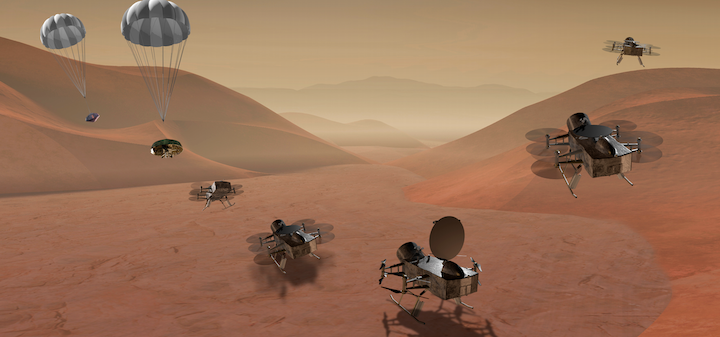
Unlike drones on Earth, Dragonfly will have to operate in a surface temperature environment of -179° C (-290° F) with an average surface pressure 50% higher than Earth’s.
After atmospheric entry, the craft’s heatshield will fall away and Dragonfly will drop from inside the back shell, and then start its rotors to perform a precision soft landing onto the surface of titan.
Power for the spacecraft during flight will come from batteries that will be recharged from a Multi-Mission Radioisotope Thermoelectric Generator.
A single battery charge will allow Dragonfly to travel 60km – farther than all the Mars rovers have driven, combined – and stay airborne in Titan’s atmosphere for 2 hours at a time.
During each of Titan’s 8-Earth-day nights, Dragonfly will be grounded to perform scientific observations until daybreak.
The rotorcraft will also sport LED lights to allow for night-time scientific and photographic operations, just as the Phoenix polar lander and Curiosity rover on Mars did and do, respectively.
Dragonfly is anticipated to weigh 450 kg (990 lb) – roughly the size of the Mars rovers Spirit and Opportunity – and fit within a 3.7 meter diameter heatshield that will protect it during entry into Titan’s atmosphere.
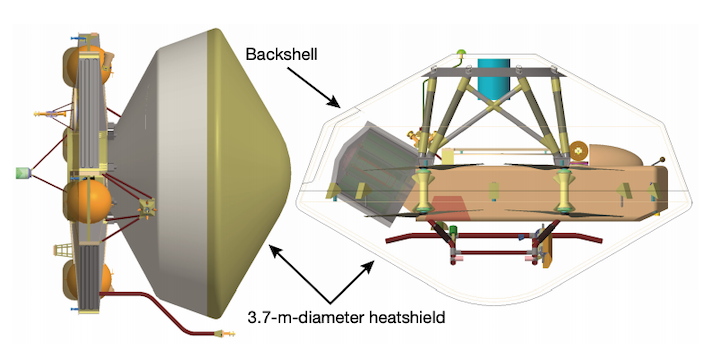
The craft will carry four scientific payloads including a mass spectrometer, a gamma-ray and neutron spectrometer, a geophysics and meteorology package, and a camera suite.
The scientific payloads will allow for the identification of chemical components, especially those relevant to biological processes, in surface and air samples; characterization of Titan’s weather and hydrologic cycle; and surveying of the local terrain for science targets.
The ultimate scientific objective of Dragonfly is to measure the composition of materials in different geologic settings on Titan to reveal how far prebiotic chemistry has progressed in the moon’s environments that provide known key ingredients for life: pyrimidines and amino acids.
Quelle: NS
----
Update: 17.07.2019
.
Yale researcher has a window seat for planning NASA’s Dragonfly mission
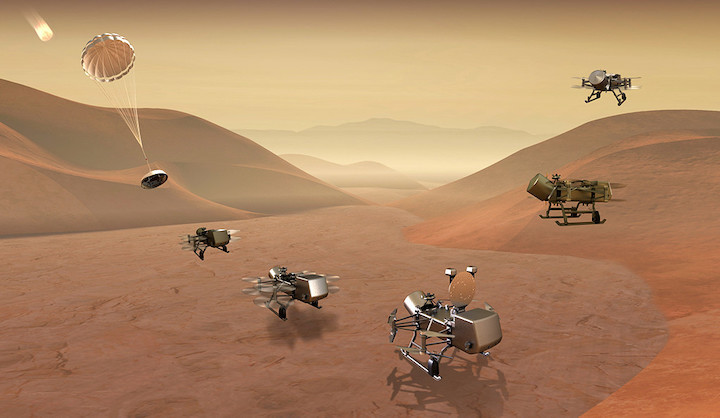
By 2034, when the Dragonfly drone mission makes landfall on the surface of Titan, Yale’s Juan Lora will have spent nearly half his life studying the climatic tendencies of Saturn’s icy moon.
That’s when the real work will begin, he says.
Finally, after long years of preparation and modeling, Lora and his colleagues on the scientific end of the NASA Dragonfly mission will begin to get a better picture of the atmosphere and weather on Titan. In doing so, they may get a clearer glimpse into how Earth’s atmosphere formed long ago.
“In many ways, Titan is more similar to Earth than Mars is, yet we know so little about it,” says Lora, 32, who joined the Department of Geology and Geophysics in January as an assistant professor. “We have this other planetary body in our own solar system that can tell us how atmospheric physics and chemistry work under different conditions. It’s an exciting opportunity.”
NASA announced funding earlier this month for Dragonfly, in which a drone-like craft will land on Titan and investigate its habitability and prebiotic chemistry at dozens of sites. Dragonfly also will monitor atmospheric and surface conditions, study seismic activity, take images of terrain, and evaluate geological processes on Titan.
The mission is scheduled to launch in 2026. It will take eight years to make the 886-million-mile trip to Saturn.
Lora says he didn’t hesitate when he was asked to join Dragonfly’s 30-member science team in 2017. He’s been studying Titan since he was a doctoral student, developing global climate models of the moon.
“It’s this amazing place,” he says. “Titan is cold, but its atmosphere is made up mostly of nitrogen, just like Earth, and it has a hydrologic cycle that is also like Earth’s, except with methane instead of water. It’s amazingly terrestrial, yet there’s so much about Titan we don’t know. We don’t even know what the surface is made of.”
Titan is larger than the planet Mercury and is the second-largest moon in our solar system. It has a surface temperature of about minus-290 degrees Fahrenheit.
A previous space mission, Cassini, studied Saturn and its surrounding rings and moons for more than a decade, completing 294 orbits around the planet. That mission also collected a limited amount of data directly from Titan after landing the small Huygens probe in 2005.
Dragonfly will take that a step further, gathering more and different data during its two-years-plus on Titan. For example, it will be able to collect atmospheric data continuously and make flights of several kilometers at a time. Lora says it will cover more ground than all of the Mars rovers put together.
“I helped with the assessment of the climate expected for when and where we’re going,” Lora explained. “We selected a landing site in a place with a lower probability of bad weather. It’s similar in latitude and seasonality to the landing spot for the Huygens probe.”
Dragonfly will be the first NASA mission to fly a multi-rotor vehicle (the drone has eight rotors) to conduct science research on another planet. It will have the ability to carry its entire science payload to multiple sites and repeat experiments. Among its target locations are the floor of a crater where water and complex organic materials key to life once existed, and organic dunes.
Dragonfly is part of NASA’s New Frontiers program, which includes the New Horizons mission to Pluto and the Kuiper Belt, the Juno mission to Jupiter, and the OSIRIS-REx mission to the asteroid Bennu. The principal investigator for Dragonfly is Elizabeth Turtle, who is based at the Johns Hopkins Applied Physics Laboratory.
As the Dragonfly science team spends the next few years preparing for launch, Lora says much of the focus will be on preparing for the unexpected and being cognizant of all the things they don’t fully understand about Titan. For example, unlike Earth, Titan’s clouds and rain are made of methane.
“We don’t know why the atmosphere there is so saturated with methane,” Lora says. “This is vitally important when you’re creating models of the atmosphere, which is something I’ve been very involved with. How you distribute methane on a planet’s surface affects so much, from cloud formation to winds. We have to be realistic about the possibilities.”
And so, Lora and his colleagues will continue to review Cassini data and keep refining their models of Titan’s atmosphere in anticipation of Dragonfly. Lora says Dragonfly will revitalize public interest in Titan and answer many more questions — before the next mission.
“Outer solar system exploration comes in spurts. We only get to go once in a long while, so we get as much data as we can, then spend years analyzing it,” he says.


